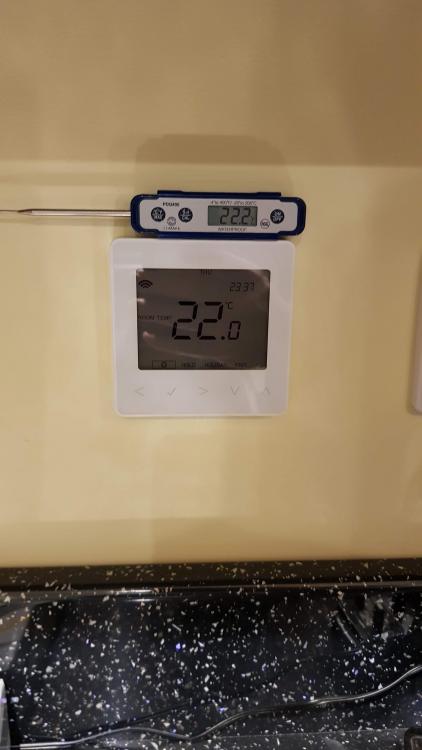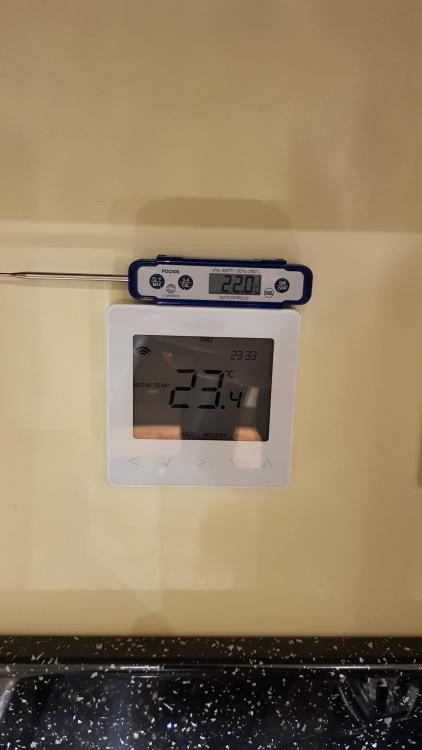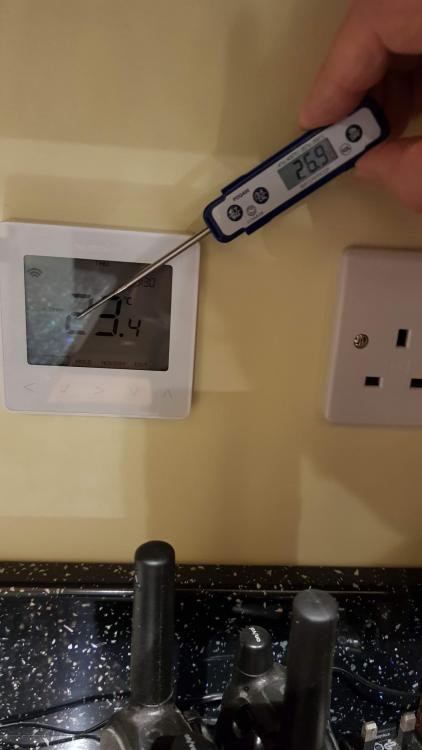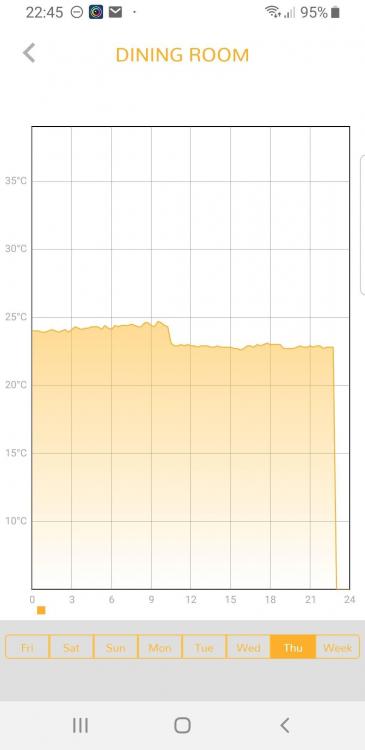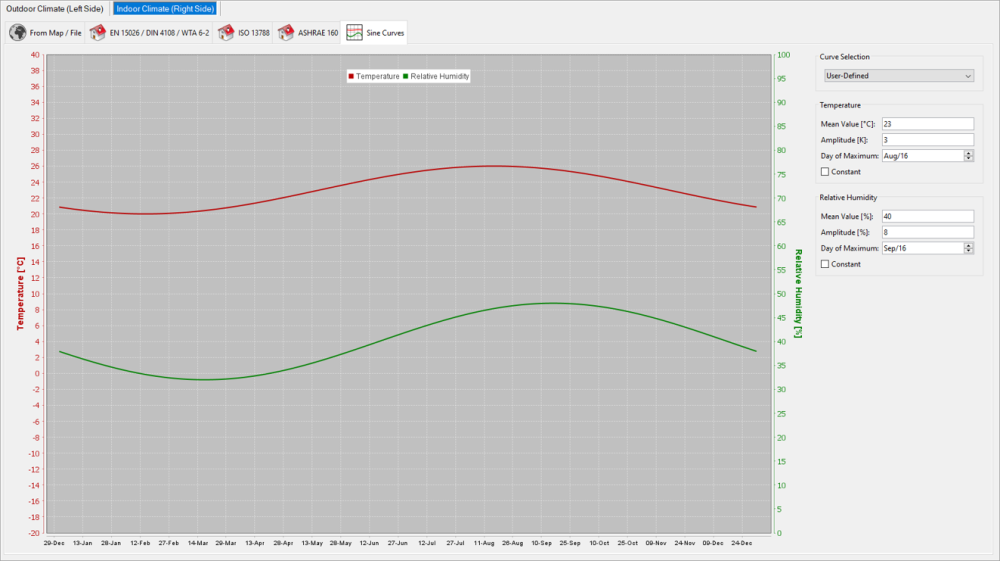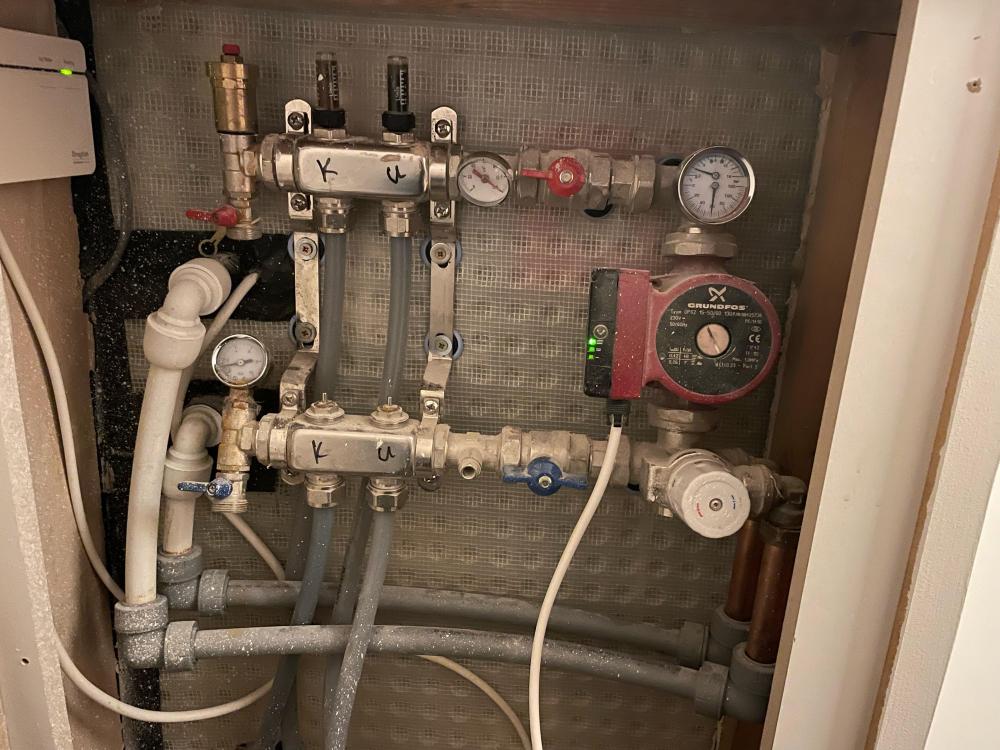Search the Community
Showing results for tags 'temperature'.
-
I have a Samsung ASHP linked via Heatmiser controls to a 14 zone, 21 loops UFH system. We commissioned this back in March 2020 just before lock down and after 1 week, it shut down as the property is passive insulated and triple glazed. Airtight too at just 0.17achr. Due to lock down delaying our finishing and selling the old place we finally moved in in September. Since the cold weather in early December I've been trying to get the heating system to work to our requirements. Initially sitting in the lounge and not being warm enough despite the Neostat showing 23deg, I invested in a calibrated thermometer and set about calibrating the Neostats to this. Property has MVHR too, so adds to the overall picture. This has now been nearly two months of adjusting but recently discovered that when the MVHR was switched off, the stats jump up in temperature value and records the house warming up overnight when the heating is off. So further probing found that the stats are recording their own heat. Front panel runs at 27 degs, the thermistor sensor on the bottom edge has no natural vents in the rest of the housing so with no air movement, the central heat of the stat just warms this up. Taking the stat off the wall I found the rear fixed plate running at 29 degrees. Top this all off with the fact that the bathrooms with remote sensors are fine and record the actual temperature and are not affected by MVHR airflow leads me to conclude that the Neostats are not fit for purpose. They generate too much internal heat to read correctly. To prove this I took one apart, drilled four holes in each side of the housing at the top and behold, it reads more accurately, now only 0.6 deg high with still air as opposed to 2 deg plus beforehand. The photos show the temperature with the stat given a gentle hand fan movement of air, still air without fan and the temperature of the face. The final one shows the drop in recorded temperature when. the MVHR cuts in. Note this MVHR is a Brink Flair 400 running at just 50m3/hr in this shot, the dining room being over 120m3, it is not the slightly cooler air hitting the stat directly as the dining room outlet will be serving up only about 6m3/hr but merely the stirring of the air stopping or reducing the stat reading its own temperature. So thanks for reading this far and just wondering if anyone has had head scratching moments with these stats? Going to try buying a decent looking remote thermistor and hooking it up just below the stat to see if this cures the problem and then seek redress through Heatmiser who have already suggested using remote sensing. Their suggestion rather reinforces my view of not fit for purpose.
- 130 replies
-
- neostat
- temperature
-
(and 1 more)
Tagged with:
-
As per the title, I'm wondering if anyone with MVHR has kept a log of internal temperature and humidity data. I'm playing with the free version of WUFI, and while it can derive the internal climate by adjusting external climate data to take into account heating and aircon, there's nothing for MVHR. Which seems a surprising omission, unless it's only in the paid versions. In the absence of that, the next best option would be to define sine curves for the internal temperature and humidity, but there seems to be a lack of easily discoverable data on that. I've posted my initial guess below, but it would be good to have something to validate / correct this against:
- 40 replies
-
- mvhr
- relative humidity
-
(and 3 more)
Tagged with:
-
The term "thermal mass" comes up time and time again on building related forums and discussions, yet as a parameter it has one notable feature - it does not really exist. There is no such thing as "thermal mass" and never has been. Mass is a simple physical property, in simple terms it's approximately how much a given volume of something weighs at the surface of the earth. This, in turn, depends on the density of the material. For example, here are some densities for some common building related materials, in terms of the weight at the Earth's surface for a 1m square cube of the stuff (1m2? Brick ~ 2000kg/m2 Concrete~ 2400kg/m2 Plaster and plasterboard ~ 2700kg/m2 Water ~ 1000kg/m2 Structural softwood ~ 550kg/m2 Typical hardwood ~ 700kg/m2 Granite ~ 2700kg/m2 On its own the mass of a given volume of material isn't that useful for working out how much heat it would take to either raise the temperature of the stuff, or for it to give off heat as it cools down. What we need to know is the specific heat of the material, expressed as the amount of heat energy (called sensible heat, which can be measured in Joules, J) needed to change the temperature of a certain mass (lets say 1m3 to match the data above) by 1 deg C (or more correctly a deg K, but it's the same thing for this purpose). So let's list the same materials as above, with the amount of heat energy we need to put into increase the temperature of 1kg of it by 1 deg ? Brick ~ 840 J/deg C Concrete ~ 880 J/deg C Plaster and plasterboard ~ 1080 J/deg C Water ~ 4200 J/deg C Wood ~ 1700 J/deg C (This is an average value, as the true range is dependent on variety, with a wide range, from 1200J/degC/kg to around 2300J/deg C/kg) Granite ~ 790 J/deg C So, if you want to create a house with the highest "thermal mass" (i.e. Heat capacity per unit mass, if that's a reasonable way of trying to define this unknown term), then here is a list of materials, with the highest heat capacity for 1 kg at the top, and lowest at the bottom: Water Wood Plaster or plasterboard Concrete Brick Granite You may well spot a few odd things here. The first is that you cannot build a house with water (but you can include water as a heat distribution or storage system). The second is that concrete, brick and stone aren't great materials in terms of storing heat for a given mass. Surprising, isn't it? Even more so when building professionals keep harping on about the virtues of so-called "thermal mass".
- 122 replies
-
- 4
-

-
- thermal mass
- heat capacity
- (and 4 more)
-
So I had some Underfloor heating (re)installed in my kitchen/diner. With the thermostat set to 19C, the floor in the kitchen gets up to about 33C (measured with a gun) while the larger living area rarely gets to about 24C. This isn't too comfortable underfoot and I'd rather the kitchen wan't being heated so much, food etc. The whole area is one zone from the manifold. The water temperature at the manifold is set to minimum (35C) but the manifold temperature gauge says 50-55C when the system is running. the engineer that installed it said to try turning the zone's flow rate down, which seemed to make it worse. I tried turning it up but there is still a big difference between these areas. Is there anything else I can try? 55C seems a bit hot from what I've read, but I don't know how to turn the temperature down any more.
- 4 replies
-
- underfloor heating
- temperature
-
(and 1 more)
Tagged with:
-
Hi, I had a mid life crisis and decided to rip out the central heating system and install underfloor heating ? The project isn't finished yet, but most of the rooms now have heating. This is a retrofit system using overboards with pipes laid in them at 150mm centres. I have a couple of questions that I'd like to get a better understanding of (bit late, I know!). Q1 - Efficient UFH temperature I don't know much about thermal dynamics, so hypothetically, if I have a system that loses 1 degree per hour when the heating is off, and it takes 1 hour to increase the temperature by 1 degree when it is on, would it be more efficient to let the heating go from 21 to 18 over 3 hours and then from 18 to 21 over another 3 hours, or would it be better to go from 21 to 20 and then back to 21 every two hours, or doesn't it make a difference? The reason for this question is that I'm thinking of leaving it polling constantly between 20 and 21 degrees. Q2 - UFH max floor temperature dilemma I currently have the manifold set to 42 degrees. This is taking a lot of time to get up to room temperature (5-8 hours, and it's not even winter yet!). The problem is, if I set the temperature any higher then the floor gets above 27 degrees (tested with an infrared thermometer, although this may be inaccurate?), and as most of the house is laminate, I believe this is not a good idea. I did think about installing floor probes, but I figured that once the floor got above 27 degrees, the heating would cut off until the floor temperature dropped below 27, which may protect the floor, but would defeat the object of trying to heat the house, albeit heat would still be coming from the floor? I also assume that once the temperature drops outside in the winter, the floor won't reach 27 unless I increase the output temperature from the manifold, so it will be a juggling act through the seasons? As you can see, I didn't think this through first ? and I hope I haven't left out any vital information in these questions. Still glad I did it though! Regards
-
Been quite a bit if talk about thermostats and temp just recently and got me thinking what do people have their house temp set at? I used to do some work for a lady that had her house set at 27c and I used to perspire profusely. A young couple rent a house of us and they have it set at 25c. We have our house set at 19c and will prob be happy with 20/21 when we move into our new house.
- 23 replies
-
- heating
- thermostat
-
(and 1 more)
Tagged with:
-
Hi I've been reading a lot of very informative posts in the forum relating to UFH & MVHR and think it is the way I will go with our new build. However...one thing I am struggling with is that we like our bedrooms to be a few degrees cooler than our living spaces, e.g. 21 in Kitchen/Living/Dining and 18 in upstairs bedrooms. Am I right in thinking that if we only have heat on downstairs, the MVHR will distribute some of that heat upstairs? If this is the case, in a well insulated, airtight house surely the temperature upstairs will eventually be the same as downstairs? Appreciate any advice, especially from anyone who has been living with MVHR. Thanks
- 25 replies

